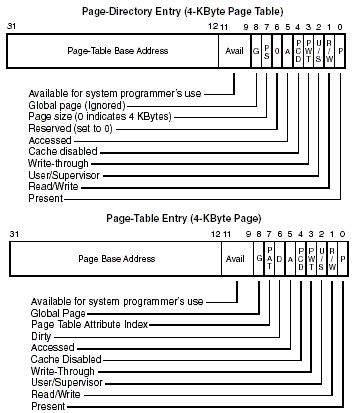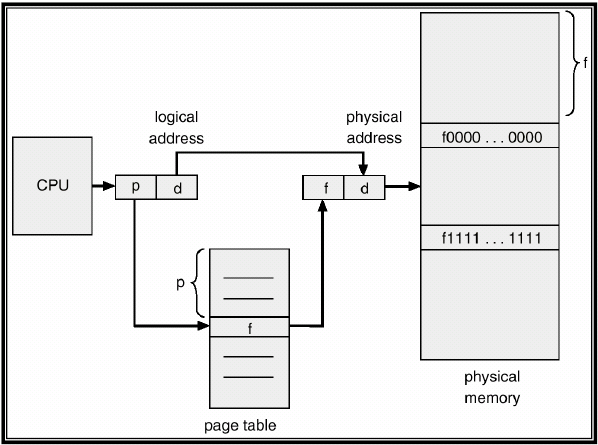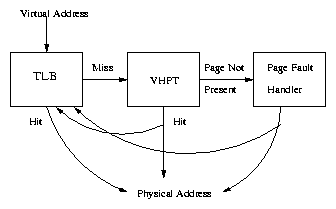In the first computers, memories were reduced and normally programs wouldn't fit in them, slow algorithms were used, and to address this problem the memory was divided in pieces and secondary memories were used to load some of this pieces of processes into the main memory, and the others into a secondary memory for later use. This is called memory overlay.
Even so, this still brought many problems to programmers because they had to work with the address of the overlays which brought as consequence the idea of paging. Paging is a method to separate the memory space from addresses and addresses from memory in the main memory of the computers, this idea was came to be in 1961 from a group of researchers in Manchester, England.
In paging, the address space is divided in pieces, called pages and the physical memory is divided in pieces of the same size called frames which allows large spaces of memory to be reduced in small pieces.
An address space may feature a n quantity of bits which can address 2^n addresses. Dividing this address space in pieces decreases this number, which makes the administration of this address space more simple.
The address space is also divided, for example, if we have an address space of 32 bits, and frames of 4kb, which is equivalent to 2^12 physical memory addresses, the last 12 bits of the address are assigned to the addressing inside the frames, and the other 20 at the left, are assigned to the frame's address space, leaving 2^20 addresses managed by the operating system, doing a more lighter job.
0000 0000 0000 0000 0000 0000 0111 1111
|_____________________| |____________|
| |
| v
| Memory location within the page
v
Page Number
Another attribute of paging is its abstraction, which allows a logical address to point at a page even when the page is not in the range of addresses of the memory frames, this can take advantage of all the logical address space in the computer.
Page Table
The page table is a structure which performs the translation of logical addresses into physical addresses from the memory. Besides this, the page table keeps track of the pages, and improves the security of the pages, managing the writing, reading, and executing permissions
The most common fields in a page table are:
The address of the frame in memory
Presence bit used to know tell if the page is found.
The dirty bit used to know if a file has been modified in the main memory, and must be updated in secondary memory.
Persistence bit
Writing, reading and modification bit.
To translate logical addresses into physical addresses, the logical address is divided in the number of pages and the displacement, then the number of pages is used to find it inside the page table, once the address of the page is found , the displacement is added to the memory inside the page, and that's how the physical address is found.
Despite the number of addresses managed with paging being decreased, the page tables can be extremely large, so different techniques are used to organize this tables.
Page Fault
If the presence bit in the memory marks that is not present in the main memory, the MMU responds by rising and exception(commonly called page fault). If the page is found in the swap space, the operating system will invoke an operation called page replacement, to bring the page required to the main memory. This operation takes several steps and it may be time-consuming.
TLB
Even if tables decreases the quantity of managed addresses, these can be very large and slow, so a cache memory is used. This memory can reside between the memory and the cache itself or between the cache and the main memory unit. This memory is very fast, but small. Typically the TLB has between 2 and 2048 entries. So, before accessing to the page table, the hardware looks in the TLB, if the logical address is there, so is the corresponding physical address and it's accessed directly. If it's not there, the hardware looks in the page table, and then the memory, and saves the access in the TLB
Algorithm for accessing a virtual address:
- The MMU receives from the CPU a dir -virtual.
- MMU searches( in parallel) dir -virtual in the TLB memory. If it's successful go to step 7.
- Search the address in the page table. If it's successful go to step 6, if else, generate a page fault.
- Execute a strategy of page replacement
- Swap pages between disk-memory
- Delete the TLB and update the page table.
- Update the TLB
- Generate a physical address and search for data in memory. If it's not successful, consult for data in the page table.
- MMU returns the requested data.
References:
http://nits.com.ar/uadeclasses/clase11.html
http://viralpatel.net/taj/tutorial/paging.php
http://www.pling.org.uk/cs/ops.html
http://es.wikipedia.org/wiki/Paginaci%C3%B3n_de_memoria
http://es.wikipedia.org/wiki/Translation_Lookaside_Buffer
http://expo.itch.edu.mx/view.php?f=os_42#page6
Organización de computadoras. Un enfoque estructurado, 4ta Edición - Andrew S. Tanenbaum



Por esta discusión les pongo +1 en el rubro "Estudios sobre el desempeño de memoria virtual".
ResponderEliminar